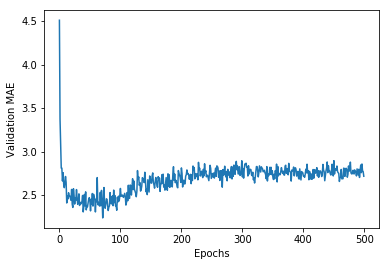还有一种常见的机器学习问题是回归问题,它预测的是连续值而不是离散标签,例如,根据气象数据预测明天气温,或者根据软件说明书预测项目完成所需要的时间。
数据介绍
这里我们介绍一下数据。要预测的是是20世纪70年代波士顿房屋价格的中位数。这里给出的数据包括犯罪率、当期房产税率等。本次,我们有的数据点相对较少,只有506个,分为404个训练样本和102个测试样本。输入数据的每个特征都有不同的取值范围。有些特征是比例,取值范围为0-1,有的特征取值范围为1-12;还有的特征取值范围为0-100等。
from keras.datasets import boston_housing
(train_data, train_targets), (test_data, test_targets) = boston_housing.load_data()
train_data.shape
test_data.shape
结果分别是:
(404, 13)
(102, 13)
这里每个样本有13个特征,比如犯罪率、每个住宅平均房屋间数、告诉公路的可达性等。
我们的目标(或者说希望的测试结果)是房屋价格的中位数,单位是千美元
train_targets
array([ 15.2, 42.3, 50. , 21.1, 17.7, 18.5, 11.3, 15.6, 15.6,
14.4, 12.1, 17.9, 23.1, 19.9, 15.7, 8.8, 50. , 22.5,
24.1, 27.5, 10.9, 30.8, 32.9, 24. , 18.5, 13.3, 22.9,…
对数据格式进行处理
将取值范围差异很大的数据直接输入到神经网络中,虽然网络会自动适应这种取值范围不同的数据,但是不进行数据处理直接学效果很不好。因为数据差异比较大的数据在网络中会整体学习效果有较大影响,所以我们需要先做标准化处理(0-1标准差)。
mean = train_data.mean(axis=0) # axis = 0表示变成一行,实际上是求每列均值
train_data -= mean
std = train_data.std(axis=0)
train_data /= std
test_data -= mean
test_data /= std
构建网络
由于样本很小,所以我们用一个非常小的网络,其中包含两个隐藏层,每层有64个单元,一般来说,训练数据越少,过拟合就会越严重,而较小的网络可以降低过拟合。
from keras import models
from keras import layers
def build_model():
# Because we will need to instantiate
# the same model multiple times,
# we use a function to construct it.
model = models.Sequential()
model.add(layers.Dense(64, activation='relu',
input_shape=(train_data.shape[1],)))
model.add(layers.Dense(64, activation='relu'))
model.add(layers.Dense(1))
model.compile(optimizer='rmsprop', loss='mse', metrics=['mae'])
return model
网络的最后一层只有一个单元,没有激活,是一个线性层。这是标量回归(标量回归是预测单一连续值的回归)的典型设置。添加激活函数将会限制输出范围。例如,如果向最后一层添加sigmoid激活函数,网络只学会预测0-1范围内的值。这里最后一层是纯线性的,所以网络可以学会预测任何范围内的值。
这里,我们使用了mse损失函数(均方误差),这是回归问题常用的损失函数。
K折交叉验证
由于我们数据点很小,验证集会非常小(比如大约100个样本)。因此,验证分数可能会有很大波动,不同划分的结果可能会对数据产生较大的影响,所以我们使用K折交叉验证。
import numpy as np
k = 4
num_val_samples = len(train_data) // k
num_epochs = 100
all_scores = []
for i in range(k):
print('processing fold #', i)
# Prepare the validation data: data from partition # k
val_data = train_data[i * num_val_samples: (i + 1) * num_val_samples]
val_targets = train_targets[i * num_val_samples: (i + 1) * num_val_samples]
# Prepare the training data: data from all other partitions
partial_train_data = np.concatenate(
[train_data[:i * num_val_samples],
train_data[(i + 1) * num_val_samples:]],
axis=0)
partial_train_targets = np.concatenate( # concatenate合并两个array数组,按行合并,axis =0 ,竖着合并
[train_targets[:i * num_val_samples],
train_targets[(i + 1) * num_val_samples:]],
axis=0)
# Build the Keras model (already compiled)
model = build_model()
# Train the model (in silent mode, verbose=0)
model.fit(partial_train_data, partial_train_targets,
epochs=num_epochs, batch_size=1, verbose=0)
# Evaluate the model on the validation data
val_mse, val_mae = model.evaluate(val_data, val_targets, verbose=0)
all_scores.append(val_mae)
我们这里设置迭代次数为100,运行结果如下:
all_scores
[2.0750808349930412, 2.117215852926273, 2.9140411863232605, 2.4288365227161068]
np.mean(all_scores)
2.3837935992396706
可以看到,经过4折交叉验证之后,预测结果和真实房间基本相差2400美元。
我们下面做500轮次,并修改最后一部分代码:
from keras import backend as K
# Some memory clean-up
K.clear_session()
num_epochs = 500
all_mae_histories = []
for i in range(k):
print('processing fold #', i)
# Prepare the validation data: data from partition # k
val_data = train_data[i * num_val_samples: (i + 1) * num_val_samples]
val_targets = train_targets[i * num_val_samples: (i + 1) * num_val_samples]
# Prepare the training data: data from all other partitions
partial_train_data = np.concatenate(
[train_data[:i * num_val_samples],
train_data[(i + 1) * num_val_samples:]],
axis=0)
partial_train_targets = np.concatenate(
[train_targets[:i * num_val_samples],
train_targets[(i + 1) * num_val_samples:]],
axis=0)
# Build the Keras model (already compiled)
model = build_model()
# Train the model (in silent mode, verbose=0)
history = model.fit(partial_train_data, partial_train_targets,
validation_data=(val_data, val_targets),
epochs=num_epochs, batch_size=1, verbose=0)
mae_history = history.history['val_mean_absolute_error']
all_mae_histories.append(mae_history)
下面我们可以计算每个轮次中所有折MAE的平均值。
average_mae_history = [
np.mean([x[i] for x in all_mae_histories]) for i in range(num_epochs)]
画图
import matplotlib.pyplot as plt
plt.plot(range(1, len(average_mae_history) + 1), average_mae_history)
plt.xlabel('Epochs')
plt.ylabel('Validation MAE')
plt.show()
这里,我们看到纵轴范围比较大,而且数据方差比较大,这张图所表达的规律不太明显。所以我们:
-
删除前10个点
-
将每个数据点替换为前面数据点的移动平均值,来得到光滑曲线
def smooth_curve(points, factor=0.9):
smoothed_points = []
for point in points:
if smoothed_points:
previous = smoothed_points[-1]
smoothed_points.append(previous * factor + point * (1 - factor))
else:def smooth_curve(points, factor=0.9):
smoothed_points = []
for point in points:
if smoothed_points:
previous = smoothed_points[-1]
smoothed_points.append(previous * factor + point * (1 - factor))
else:
smoothed_points.append(point)
return smoothed_points
smooth_mae_history = smooth_curve(average_mae_history[10:])
plt.plot(range(1, len(smooth_mae_history) + 1), smooth_mae_history)
plt.xlabel('Epochs')
plt.ylabel('Validation MAE')
plt.show()
从图中可以看出,验证MAE在80轮后不再显著下降,之后开始出现过拟合。
训练最终模型
我们得到最佳迭代次数这个超参数,大概是80,下面在全部训练集上训练结果
# Get a fresh, compiled model.
model = build_model()
# Train it on the entirety of the data.
model.fit(train_data, train_targets,
epochs=80, batch_size=16, verbose=0)
test_mse_score, test_mae_score = model.evaluate(test_data, test_targets)
结果是:
test_mae_score
2.5532484335057877
预测房价和实际值大概相差2550元。
更多精彩内容,欢迎关注我的微信公众号:数据瞎分析


